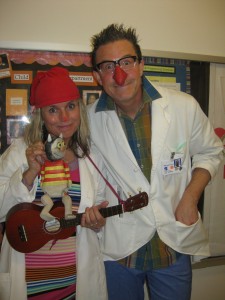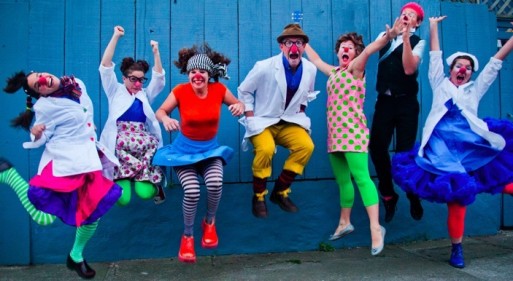
Dan with Fullbright Scholar Marka, who is working with ClownZero at UCSF Benioff Children’s Hospital
This is an interview with Dan Griffiths, a therapeutic clown and Executive Director of ClownZero in San Francisco. ClownZero is a San Francisco based, community supported, non-profit organization dedicated to improving life for children and communities worldwide through humanitarian clowning and therapeutic performing arts for those with serious illnesses.
ClownZero currently maintains the Healing Through Humor Program in residence at UCSF Benioff Children’s Hospital and the ClownZero Response Team, a group who responds to communities and individuals in crisis worldwide. From their website: “We believe that a clown personifies the humanity in all of us and is uniquely suited to communicate beyond barriers of age, race, culture or gender creating greater levels of human connectivity and emotional buoyancy.”
Dana: What is your experience as a clown with children facing the end of life?
Dan: When we clown for someone, rarely do we know whether or not that person will survive their illness. We don’t know if it’s their “last day on earth” or anything; we’re not a “last wish” service. I did have that experience once a long time ago, where it was a last wish for a child, and it’s an incredible experience when you meet a child who knows they’re dying and wants to spend their last days laughing. Generally, though, we don’t know what the particular illness is, and it doesn’t matter.
Dana: So you don’t talk with the patients about their medical condition?
Dan: No. Sometimes they’re tiny — toddlers — so we don’t have that talk. If they offer the information, we acknowledge it, but then move on. The focus is not on their illness; it’s on their lives, their living. We approach them and try to heal them with humor, for all those wonderful medical benefits that laughter has. We try to change their mental state.
Dana: Do you work with primarily children or adults with serious illnesses?
Dan: Primarily children, but sometimes we clown for adults — sometimes really, really old adults. Recently we were clowning for veterans at the Veterans Hospital. Some guys were in hospice care, but not all. We see a lot of people of all different ages, and for adults, we work with some Alzheimer’s patients. A lot of times, for adults and children, we work in conjunction with physical or mental therapy.
I made a game last time I was with Alzheimer’s patients, where I pulled out a Santa hat and played “Who’s Santa now?” The person with the hat has to decide who gets coal or gifts — so they have to assess people and their personalities, which is a big deal for an Alzheimer’s patient.
The main goal, regardless of who we’re with, is to create an environment in which we [the clowns] become the object of play. So they’re empowered to play with us. It helps them transform how they think about a disease; for example, we can come in and act as their illness, because they can take control of it when they’re able to direct out play.
Also, by providing themselves with humor, they gain a new point of view. It changes your perspective on a situation, and laughter can help release tension. The hospital is a very serious and sterile place, and you have very little choice about what happens to you and who comes into the room (especially at a teaching hospital like UCSF). So, when we come to a room, we ask permission; we say, “Is it alright if I come in?” We wait for permission from the patient, even though parents are usually very welcoming and think it’s great we’re there.
Dana: Do the kids turn you down sometimes?
Dan: Yeah, sometimes, and it’s the best thing, because that empowers the kid to take control of their environment. No one else ever asks them permission, so they can control what we do. In that case, when they say no, I’ll offer other ways to empower them, be silly, like, “Can I stand in the doorway? Can I stand over here?” By following their direction, I can give them some control.
Dana: How is your approach different in clowning for children versus adults?
Dan: Our goal is the same, really. Even when we would do assisted living facilities, with aging adults, it’s really the same approach, going into individual rooms. When we started doing them, we started doing group shows, but realized right away that we needed to change the program to the same way we deal with kids, keep it individual and personal. The unique thing about a clown as an entertainment entity is everything they do is for you. So we’re there to witness whatever happens and go with whatever you need.
Dana: What kind of clowning did you start with?
Dan: I began performing in the theater, with mime. I still do that. I was a student of Marcel Marceau, so I was studying the realm of mime. I was learning the world of non-verbal communication. That changed me, and I didn’t want to be just a regular actor-schmactor after that. I wanted to make my own work, and then I started to discover the character that clown can be. I was traveling across the country playing schools at the time, and I was up in Appalachia (where it’s very poor). Everybody from the school and town came to the show, and I thought, This is the best. It’s for everyone — they were just people, not the people who could afford tickets to this show or whatever. Just people, enjoying the show.
Dana: What’s one final thing you’d like our readers to know about laughter as therapy?
Dan: I just think that people definitely should think about how their actions effect other people, whether it’s funny or not — because they do. You’re connected to other people; you’re not alone, and everything you do affects the people around you. You should mean to affect someone else, because you do, so do it intentionally and positively.
The ClownZero Response Team has worked with the American Red Cross, Catholic Charities, and the Panya Project in Thailand to bring joy and laughter to children and adults around the world. They will hold a therapeutic clowning workshop, where you can learn the trade, this July. Visit their website, www.clownzero.org for more details, or to make a donation.
More about laughter as medicine: “Film Review: Patch Adams”
Images courtesy of ClownZero.

 How Can Clowning Help Those With Serious Illnesses? An Interview with Dan Griffiths
How Can Clowning Help Those With Serious Illnesses? An Interview with Dan Griffiths




 Mary Oliver’s “Heavy” Speaks to the Weight of Grief
Mary Oliver’s “Heavy” Speaks to the Weight of Grief
 Did Our Ancestors Leave Behind a Map of the Afterlife?
Did Our Ancestors Leave Behind a Map of the Afterlife?
 My Dear Cousin Is Still An Angel at My Side
My Dear Cousin Is Still An Angel at My Side














